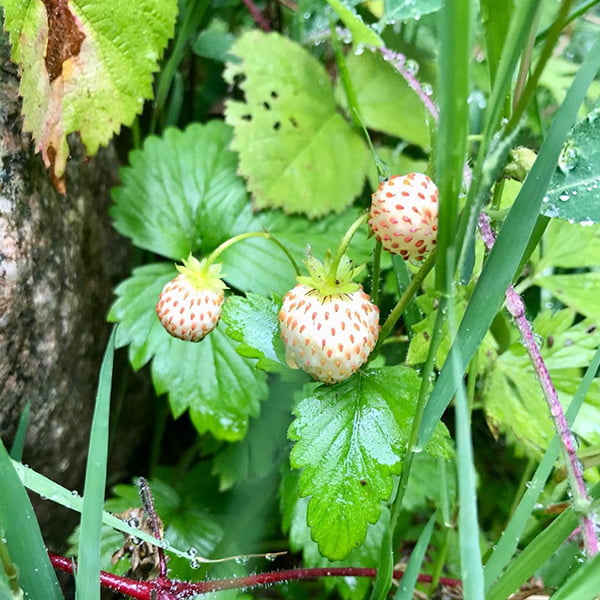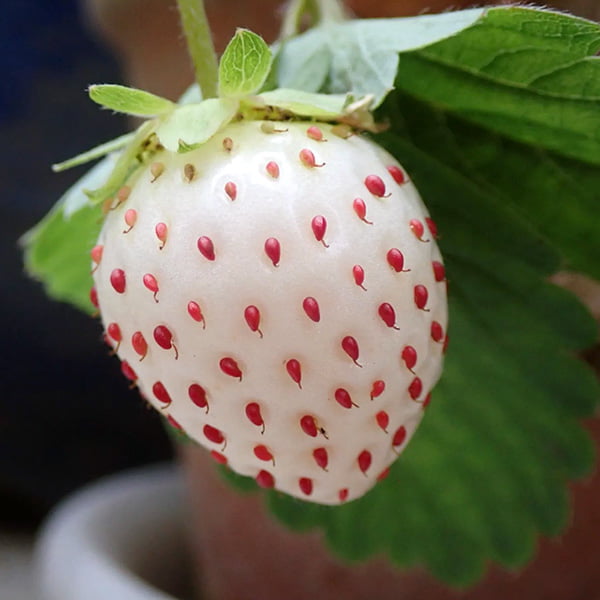When it comes to strawberries, nothing beats homegrown, organic red strawberries. But if you are looking for exotic fruit that will tingle your taste buds to the next level, you must check out white strawberries.
It's often fun to add something quirky, new fruits, and "out-of-the-box" to your vegetable and fruit garden, and white strawberries definitely fit the bill! These small strawberries stay bright white with pink patches and red seeds, even at the peak of sweetness! Underneath the surface, the white flesh is sweet and sweeter than regular red strawberries. They also have an exquisite aroma that tastes like a mix between pineapple and strawberry.
Growing white strawberries in your garden isn't hard or complicated, but this sensitive crop can have a low yield and short harvest. White strawberries are much pricier than regular strawberries, so it is definitely worth growing in your garden. Here is everything you'll need to know.
What Are White Strawberries?
White strawberries are hybrid strawberries that have white skin with red seeds. They are also called pineberries, hula berries, and alpine berries. They lack the primary ripening protein that would typically signal for a strawberry to turn red at peak ripeness, so they stay white instead, with small red seeds.
While a white strawberry grows in much the same way as red strawberries, it has a citrus flavor - almost as if you crossed a strawberry with a pineapple. They were originally grown for the Japanese luxury fruit market but are available to order from many nurseries today!
Birds tend to avoid white strawberries, which is a pleasant plus! On the flip side, white strawberry plants produce smaller berries that are fewer in number, and they don't yield a particularly bountiful harvest.
There are different types of white strawberries. It's important to note that none of them are genetically modified! These white berries are achieved through species cross-breeding, some crosses occurred with wild strawberries, and some were achieved in a nursery.

Common White Strawberry Varieties
White Jewel Strawberries
This white strawberry variety was the first variety available. The white jewel strawberry is softer and sweeter than other varieties.
White Alpine Strawberries
These are the wild varieties of the species Fragaria vesca. These varieties are also called Albicarpa, Pineapple Crush, White Giant, and White Delight.
White Beach Strawberries
They are also known as coastal strawberries, wild strawberries, Chilean strawberries, and South American Strawberries. They are part of the Fragaria chiloensis species, and these coastal strawberries are grown more frequently in South America and produce larger, plumper berries.
White Pineberries
These are a Fragaria x ananassa hybrid. If they are ripened on the vine, they may take on a somewhat pinkish hue.
White Strawberry Care Requirements
Light
White strawberries, just like red strawberries, need ample sunlight exposure. Plant them in a location that receives a minimum of 6 hours of sunlight a day, preferably more.
Water
White strawberries have simple water needs. Water the base of the plant only when the top inch of the soil is dry. Avoid getting water on the leaves, which may lead to powdery mildew. If you've planted your plants in a strawberry pot, be sure to water each individual plant - not just the entire pot from over the top.
Temperature
When planting white strawberry plants, choose a location that can be protected from late spring frosts. Otherwise, consider planting your strawberries in a pot that can be brought indoors.
White strawberry plants grown directly in the ground can stay there over the winter, provided they are heavily mulched. Otherwise, they will die off rather than go dormant.
Soil
Your white strawberries will grow well if the soil is well-draining and fertile. If planting in a pot, mix peat, sand, and organic matter into a typical potting soil.
Fertilization
You can boost the fruit production of these hybrid varieties by fertilizing the soil with compost or other organic matter prior to planting and then using a balanced liquid fertilizer every two weeks during the growing season.

Propagation
White strawberries will readily self-propagate using runners, and nodes along the vine length will put out roots if covered with soil. This frequently happens naturally, but you can purposefully propagate runners to create new plants.
Fill a pot with rich soil. Lay a runner over the pot and set a rock on top of the vine to make sure that it maintains contact with the soil in the pot.
Sprinkle a light layer of soil over the point of contact between the runner and the soil.
Water the runner whenever you water the main strawberry plant.
In four to six weeks, there will be enough root growth from the runner that you can clip it away from the main plant.
Pruning
During the first year, white strawberry gardeners choose to pinch off the flowers, and this encourages the plant to focus on root growth and become more established. In subsequent years, you can prune away runners so that the plant concentrates energy on making the white strawberries.
Harvesting
You will start noticing small white and yellow blooms in the spring, with the berry appearing four weeks later. It can be tricky to tell when white strawberries are at peak ripeness because they won't change colors like red varieties. Instead of trusting to color, feel each berry. Ripe strawberries will have a soft give to them.
Common Problems
Since birds tend not to go after white strawberries, your main pest concern will be slugs. A simple slug trap made from beer is an effective way to bait and trap them.
Powdery mildew can be a problem if moisture remains on the plant's leaves for too long. When watering, be sure to lift away the leaves and water the base of the plant. If there's been a run of overcast, rainy days, give the leaves of your strawberry plants a good shake-off.
Is There A White Strawberry Allergy?
Typically, if a person is allergic to strawberries, it is specifically the ripening protein they are allergic to. Since white strawberries lack this protein, someone with strawberry allergies may be able to consume them safely.
Are White Strawberry Plants Pet Friendly?
Yes, all white strawberry varieties are safe for pets to ingest.
